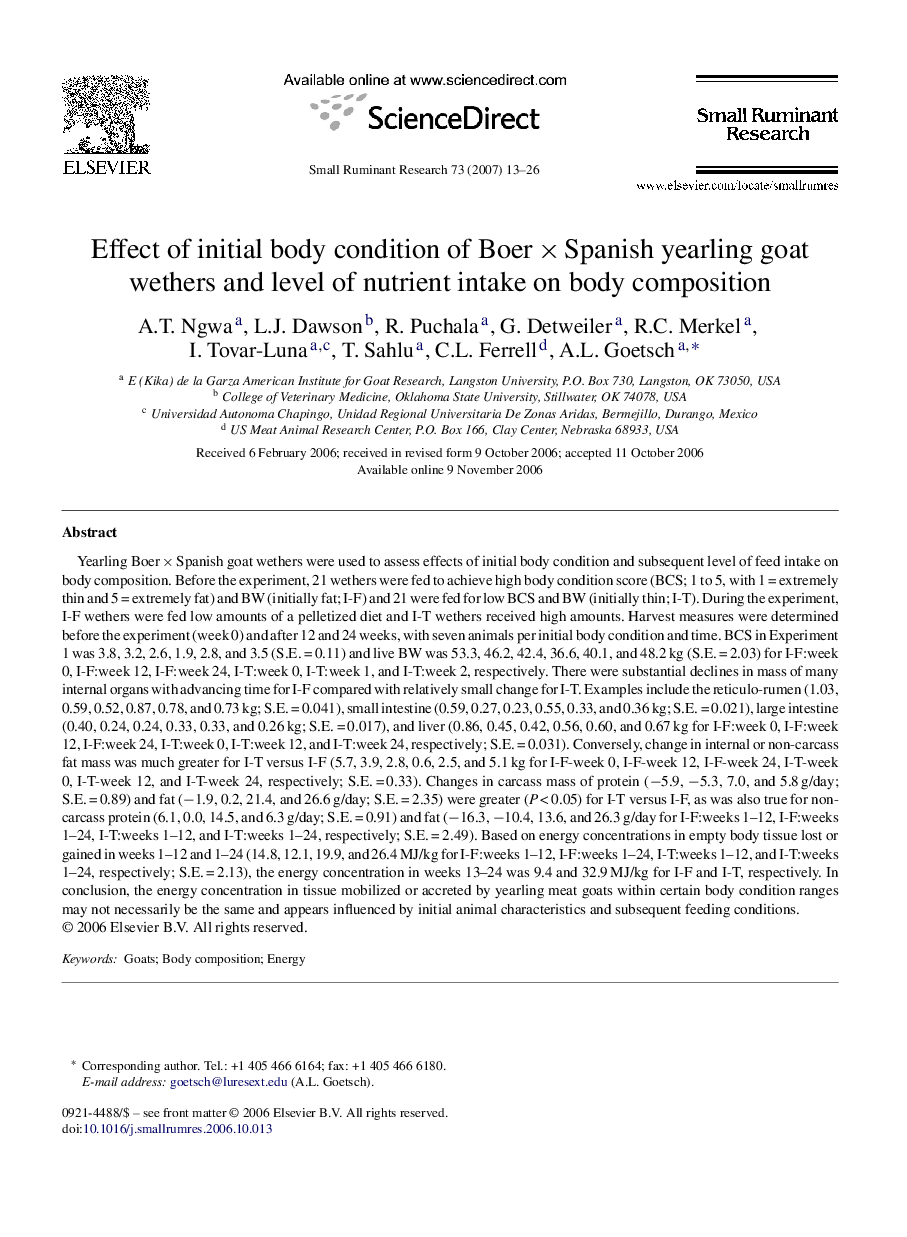| کد مقاله | کد نشریه | سال انتشار | مقاله انگلیسی | نسخه تمام متن |
|---|---|---|---|---|
| 2458055 | 1554419 | 2007 | 14 صفحه PDF | دانلود رایگان |
عنوان انگلیسی مقاله ISI
Effect of initial body condition of Boer Ã Spanish yearling goat wethers and level of nutrient intake on body composition
دانلود مقاله + سفارش ترجمه
دانلود مقاله ISI انگلیسی
رایگان برای ایرانیان
موضوعات مرتبط
علوم زیستی و بیوفناوری
علوم کشاورزی و بیولوژیک
علوم دامی و جانورشناسی
پیش نمایش صفحه اول مقاله

چکیده انگلیسی
Yearling Boer Ã Spanish goat wethers were used to assess effects of initial body condition and subsequent level of feed intake on body composition. Before the experiment, 21 wethers were fed to achieve high body condition score (BCS; 1 to 5, with 1 = extremely thin and 5 = extremely fat) and BW (initially fat; I-F) and 21 were fed for low BCS and BW (initially thin; I-T). During the experiment, I-F wethers were fed low amounts of a pelletized diet and I-T wethers received high amounts. Harvest measures were determined before the experiment (week 0) and after 12 and 24 weeks, with seven animals per initial body condition and time. BCS in Experiment 1 was 3.8, 3.2, 2.6, 1.9, 2.8, and 3.5 (S.E. = 0.11) and live BW was 53.3, 46.2, 42.4, 36.6, 40.1, and 48.2 kg (S.E. = 2.03) for I-F:week 0, I-F:week 12, I-F:week 24, I-T:week 0, I-T:week 1, and I-T:week 2, respectively. There were substantial declines in mass of many internal organs with advancing time for I-F compared with relatively small change for I-T. Examples include the reticulo-rumen (1.03, 0.59, 0.52, 0.87, 0.78, and 0.73 kg; S.E. = 0.041), small intestine (0.59, 0.27, 0.23, 0.55, 0.33, and 0.36 kg; S.E. = 0.021), large intestine (0.40, 0.24, 0.24, 0.33, 0.33, and 0.26 kg; S.E. = 0.017), and liver (0.86, 0.45, 0.42, 0.56, 0.60, and 0.67 kg for I-F:week 0, I-F:week 12, I-F:week 24, I-T:week 0, I-T:week 12, and I-T:week 24, respectively; S.E. = 0.031). Conversely, change in internal or non-carcass fat mass was much greater for I-T versus I-F (5.7, 3.9, 2.8, 0.6, 2.5, and 5.1 kg for I-F-week 0, I-F-week 12, I-F-week 24, I-T-week 0, I-T-week 12, and I-T-week 24, respectively; S.E. = 0.33). Changes in carcass mass of protein (â5.9, â5.3, 7.0, and 5.8 g/day; S.E. = 0.89) and fat (â1.9, 0.2, 21.4, and 26.6 g/day; S.E. = 2.35) were greater (P < 0.05) for I-T versus I-F, as was also true for non-carcass protein (6.1, 0.0, 14.5, and 6.3 g/day; S.E. = 0.91) and fat (â16.3, â10.4, 13.6, and 26.3 g/day for I-F:weeks 1-12, I-F:weeks 1-24, I-T:weeks 1-12, and I-T:weeks 1-24, respectively; S.E. = 2.49). Based on energy concentrations in empty body tissue lost or gained in weeks 1-12 and 1-24 (14.8, 12.1, 19.9, and 26.4 MJ/kg for I-F:weeks 1-12, I-F:weeks 1-24, I-T:weeks 1-12, and I-T:weeks 1-24, respectively; S.E. = 2.13), the energy concentration in weeks 13-24 was 9.4 and 32.9 MJ/kg for I-F and I-T, respectively. In conclusion, the energy concentration in tissue mobilized or accreted by yearling meat goats within certain body condition ranges may not necessarily be the same and appears influenced by initial animal characteristics and subsequent feeding conditions.
ناشر
Database: Elsevier - ScienceDirect (ساینس دایرکت)
Journal: Small Ruminant Research - Volume 73, Issues 1â3, November 2007, Pages 13-26
Journal: Small Ruminant Research - Volume 73, Issues 1â3, November 2007, Pages 13-26
نویسندگان
A.T. Ngwa, L.J. Dawson, R. Puchala, G. Detweiler, R.C. Merkel, I. Tovar-Luna, T. Sahlu, C.L. Ferrell, A.L. Goetsch,